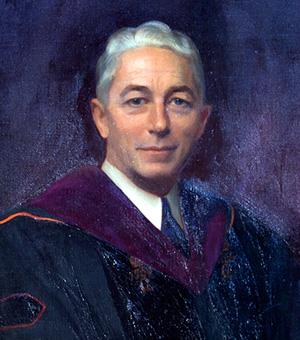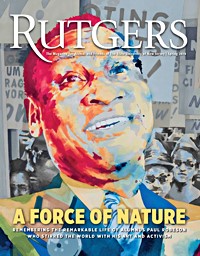Robert C. Clothier
Rutgers President, 1932 to 1951

Robert Clarkson Clothier (1885–1970) was born in Philadelphia, attended Haverford School from 1894 to 1903, and enrolled in Princeton. As an undergraduate he was editor-in-chief of the Daily Princetonian and served on the student council. Following graduation in 1908, he worked as a reporter for the Wall Street Journal and later joined the Curtis Publishing Company in Philadelphia as a personnel manager.
During World War I, Clothier was appointed to the War Department’s Committee on Classification of Personnel. As lieutenant colonel of the general staff, he served overseas as a special representative of the secretary of war. Following the war, he helped form the Scott Company, personnel consultants for industry, and served as its vice president until 1923. He then returned to Haverford School as assistant headmaster and was later named as acting headmaster. In 1929 he was appointed dean of men at the University of Pittsburgh and remained in that position until he assumed the presidency of Rutgers in 1932.
Clothier’s vision of growth and development for Rutgers coincided with the depression and war years. State appropriations were drastically reduced during the early 1930s and private gifts were not forthcoming. He nonetheless encouraged a “friendly and understanding” relationship with the State and embarked on an expansion program. In 1935 he announced the acquisition of a 256-acre tract immediately across the Raritan River. The River Road Campus, as it was called at the time, soon featured playing fields for intramural and intercollegiate athletic programs, a 22,000-seat stadium, the Chemistry Building, a faculty village, and a housing development for married students. By the 1940s, the university had acquired buildings along Georges Road for the College of Agriculture, buildings on College Avenue, and the President’s House on River Road. It had constructed an annex to the Engineering Building and transformed the Neilson Campus, now the Queens Campus mall.
In 1935 Robert C. Clothier announced the acquisition of a 256-acre tract immediately across the Raritan River. The River Road Campus, as it was called at the time, soon featured playing fields for intramural and intercollegiate athletic programs, a 22,000-seat stadium, the Chemistry Building, and housing.
During the early years of Clothier’s presidency, the curriculum was strengthened and new programs were added. The Graduate Faculty was formed in May 1932, two years later University College was established, and the following year the first graduate school of banking was initiated with the collaboration of the American Bankers Association. In March 1936, the Rutgers University Press was founded. Additional programs begun during Clothier’s first decade included the Bureau of Biological Research, the Rutgers Research Council, the State Scholarship Program, and the departments of Personnel and Placement, Alumni, and Public Relations.
With America’s entry into World War II, Rutgers found itself once again in the throes of a national emergency. Clothier immediately committed the university’s resources to the war effort. The campus became host to the Army Student Training Program, which helped maintain enrollment levels in the university. The war had a devastating effect on the university; 5,888 Rutgers men served in the armed forces and 234 men and two women lost their lives overseas. Tragedy struck Clothier and his wife with news of the death of their son during a training mission as an Air Cadet.
During the postwar years, Rutgers renewed its call for growth and expansion. Clothier declared that university policy would be to accommodate “all qualified veterans and high school graduates for whom it is possible to provide, not just those whom it is convenient to take.” Over 19,000 veterans flooded the campus to receive their education through the benefits of the G.I. Bill. In 1945, under the provisions of the State University Act, the state legislature enacted the designation of State University to all units of Rutgers. The Bureau of Mineral Research was founded in 1945, followed by the Institute of Management and Labor Relations in 1947, the Institute of Microbiology in 1949, and the Bureau of Government Research in 1950. In 1946 the College of Arts and Science, the School of Business Administration, and the School of Law of the former University of Newark were merged with the university to form Rutgers–Newark. In 1950, the university assumed control of a law school and the two-year College of South Jersey in Camden, extending the university to that portion of the state.
During this period of tremendous growth, Clothier also assumed many civic responsibilities. In the summer of 1947, he served as president of the New Jersey Constitutional Convention, held in the gymnasium on College Avenue, that produced the modern state charter. He held membership in various clubs and associations, and directorships in the Mutual Benefit Life Insurance Company and the Public Service Corporation of New Jersey. He also served a term as chair of the State Department of Higher Education’s Division Against Discrimination.
In 1951 Robert C. Clothier retired from the presidency of Rutgers University, at the age of 66. He was the recipient of honorary degrees from Princeton, Pittsburgh, Delaware, Temple, the State University of New York, New York University, Tusculum, Dickinson, and Lafayette. During his retirement he returned to Rutgers for numerous occasions and special events. He died on March 18, 1970.
This biographical sketch was authored by Thomas J. Frusciano, Rutgers University Archivist. It originally appeared in The Journal of the Rutgers University Libraries.

